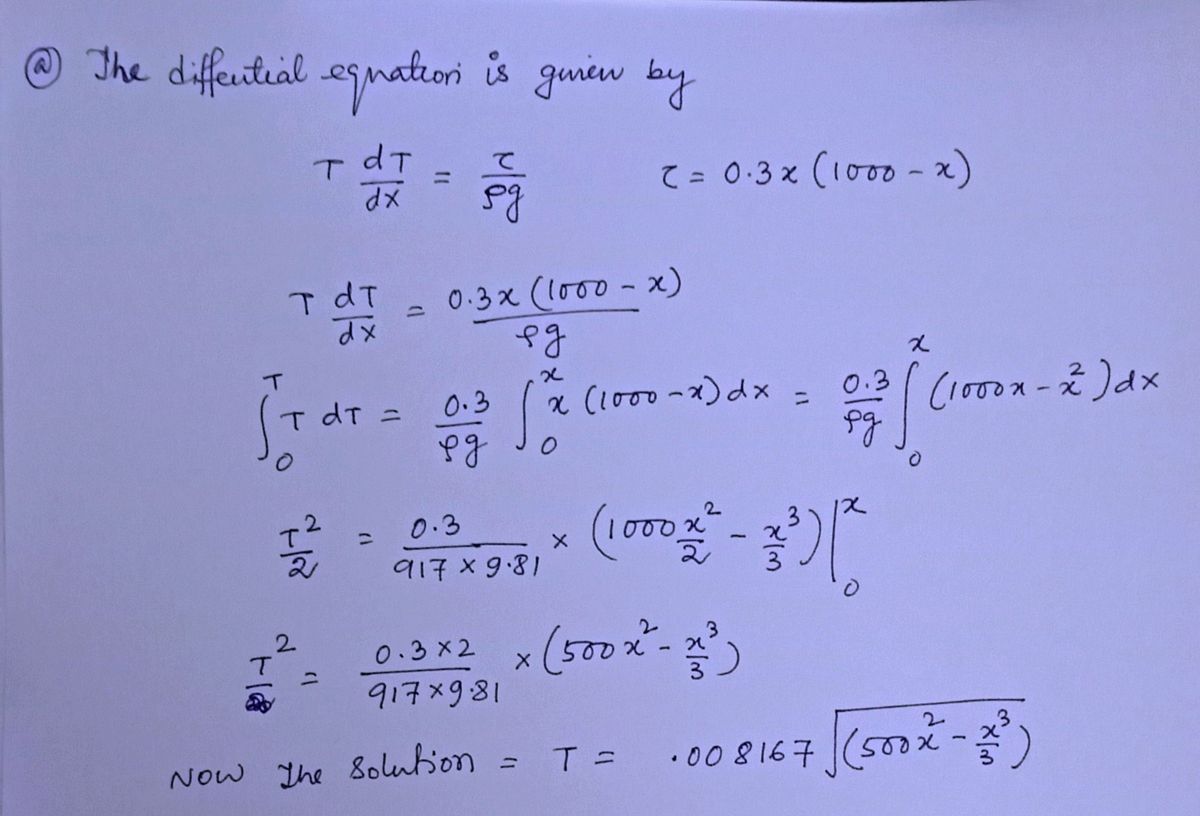Question
PLEASE ANSWER ALL PARTS ASAP!!!!!!!
![**Understanding Glacier Thickness through Differential Equations**
In this lesson, we will explore how to determine the thickness of a glacier using differential equations. The glacier thickness is represented by the function \( T(x) \), and is influenced by the variable \( \tau(x) \).
### Problem Statement
We are given the glacier thickness differential equation with:
\[ \tau(x) = 0.3x(1000 - x) \, \text{N/m} \]
With parameters:
- \( \rho = 917 \, \text{kg/m}^3 \)
- \( g = 9.8 \, \text{m/s}^2 \)
**Tasks:**
1. **Finding the Particular Solution:**
- **Initial Condition:** \( T(0) = 0 \).
- **Differential Equation:**
\[
\frac{dT}{dx} = \frac{\tau}{\rho g}
\]
2. **Analyzing Glacier Thickness:**
- Calculate the glacier's thickness at 1 km.
- Graph the function \( T(x) \) using Desmos, highlighting the solution point, and ensure the graph is appropriately scaled for clarity.
### Visual Explanation
The equation indicates that the rate of change in glacier thickness, \( \frac{dT}{dx} \), is equal to the stress \( \tau \) divided by the product of density \( \rho \) and gravitational acceleration \( g \).
#### Guidance for Graphing:
- Use appropriate scaling in Desmos to visualize changes in \( T(x) \).
- Highlight the point where \( x = 1 \) km to examine the glacier thickness at this position.
By following these steps, students will gain a better understanding of how mathematical models can be used to analyze real-world phenomena such as glacier dynamics.](https://content.bartleby.com/qna-images/question/c2daf8f3-113d-48f5-9b15-0b37d7046821/5a36e523-2ba4-4600-830d-7c5aa9006095/u7gm6i8_thumbnail.png)
Transcribed Image Text:**Understanding Glacier Thickness through Differential Equations**
In this lesson, we will explore how to determine the thickness of a glacier using differential equations. The glacier thickness is represented by the function \( T(x) \), and is influenced by the variable \( \tau(x) \).
### Problem Statement
We are given the glacier thickness differential equation with:
\[ \tau(x) = 0.3x(1000 - x) \, \text{N/m} \]
With parameters:
- \( \rho = 917 \, \text{kg/m}^3 \)
- \( g = 9.8 \, \text{m/s}^2 \)
**Tasks:**
1. **Finding the Particular Solution:**
- **Initial Condition:** \( T(0) = 0 \).
- **Differential Equation:**
\[
\frac{dT}{dx} = \frac{\tau}{\rho g}
\]
2. **Analyzing Glacier Thickness:**
- Calculate the glacier's thickness at 1 km.
- Graph the function \( T(x) \) using Desmos, highlighting the solution point, and ensure the graph is appropriately scaled for clarity.
### Visual Explanation
The equation indicates that the rate of change in glacier thickness, \( \frac{dT}{dx} \), is equal to the stress \( \tau \) divided by the product of density \( \rho \) and gravitational acceleration \( g \).
#### Guidance for Graphing:
- Use appropriate scaling in Desmos to visualize changes in \( T(x) \).
- Highlight the point where \( x = 1 \) km to examine the glacier thickness at this position.
By following these steps, students will gain a better understanding of how mathematical models can be used to analyze real-world phenomena such as glacier dynamics.
Expert Solution
arrow_forward
Step 1: Part a

Step by stepSolved in 4 steps with 3 images

Knowledge Booster
Similar questions
- urgent.arrow_forwardA car stereo pools 2.89 A from a car's battery. If the battery has a voltage of 12 V, how much power does it use? provide stepsarrow_forwardP Performance Matters Welcome, Bertiana! ► || A Tools - Question 2 of 51 Submit Test 04.CFE.2003380.2003390.2003836.2003840.Phy... A cell phone will typically have a power output of 1.4 watts when playing a song that lasts for 300 seconds. If the electrical resistance of the cellphone is 400 Q, what is the total charge needed to play the song?arrow_forward
arrow_back_ios
arrow_forward_ios